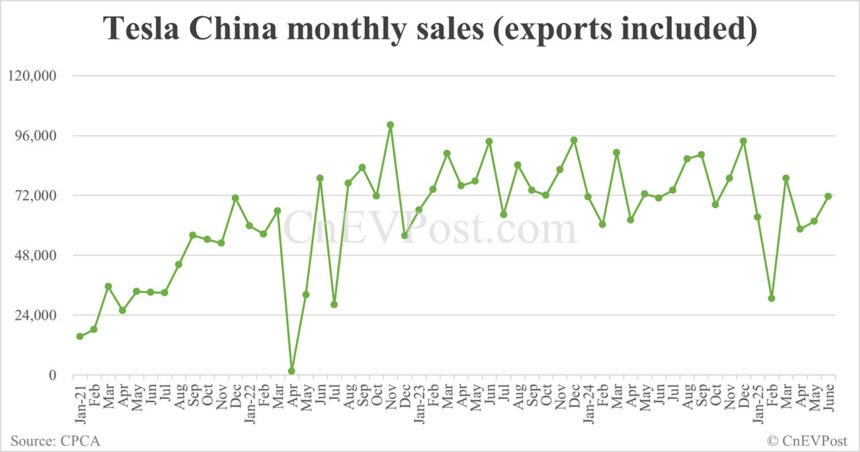Tesla China’s June sales, including exports, showed a slight increase of 0.83 percent year-on-year and a significant jump of 16.12 percent from May. This positive trend comes after eight consecutive months of year-on-year declines in sales for Tesla China.
In June, Tesla China sold a total of 71,599 vehicles, which includes both domestic sales and exports to overseas markets. This figure represents a slight increase from the same period last year and a notable increase from the previous month. The data, released by the China Passenger Car Association (CPCA), highlights the resilience of Tesla’s sales in the Chinese market.
The sales boost in June comes as a welcome reversal of the downward trend that Tesla China has experienced in recent months. From October 2024 to May 2025, monthly sales, including exports, had consistently declined year-on-year. However, the June figures indicate a positive turn for Tesla China’s sales performance.
Tesla operates a factory in Shanghai, where it produces the popular Model 3 sedan and Model Y crossover. The Shanghai factory serves both domestic customers and acts as an export hub for Tesla’s vehicles. Despite facing challenges in the market, Tesla continues to maintain a strong presence in China.
Looking at the second quarter performance, Tesla China sold a total of 191,720 vehicles, including exports to overseas markets. This figure represents a year-on-year decrease of 6.82 percent, marking the third consecutive quarter of decline in sales for Tesla China. Despite the challenges, Tesla remains a key player in the Chinese electric vehicle market.
In the first half of the year, Tesla China sold a total of 364,474 vehicles, including exports. This figure reflects a decrease of 14.57 percent compared to the same period last year. The decline in sales could be attributed to increasing competition in the market, with new players like Xiaomi entering the electric vehicle segment.
Xiaomi recently launched its YU7 electric SUV, which could potentially impact sales of Tesla’s Model Y. The YU7 offers a larger size and more affordable price point compared to the Model Y, attracting significant interest from consumers. Xiaomi’s success in the electric vehicle market poses a challenge to established players like Tesla.
In response to market dynamics, Tesla has adjusted its pricing strategy in China, raising the price of the long-range Model 3 to RMB 285,500. Additionally, Tesla has extended the range of the Model 3 to 753 km, enhancing the value proposition for customers.
Overall, Tesla’s performance in the Chinese market reflects the evolving landscape of the electric vehicle industry. With increasing competition and shifting consumer preferences, Tesla continues to adapt its strategies to maintain its position as a leading player in the market.







